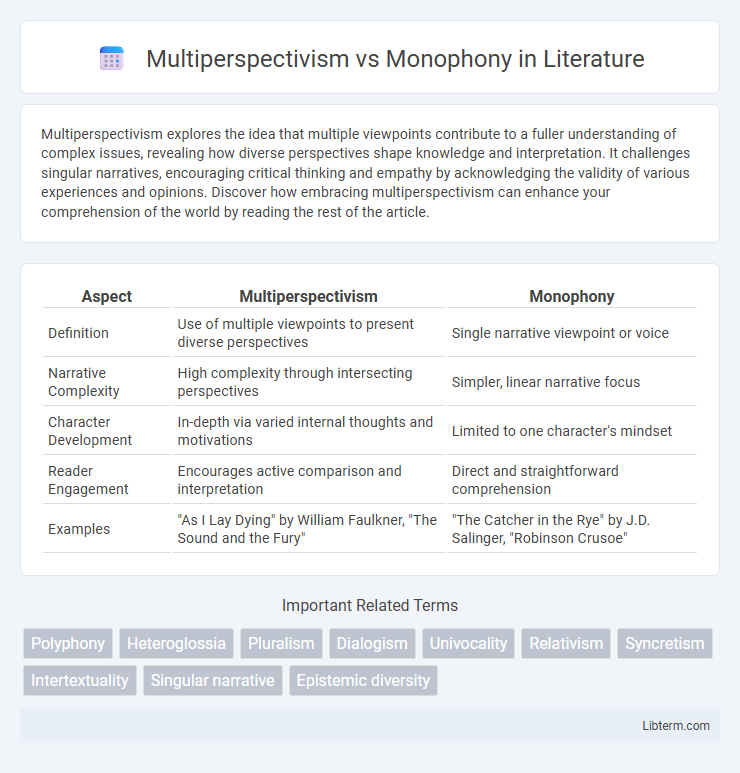Multiperspectivism explores the idea that multiple viewpoints contribute to a fuller understanding of complex issues, revealing how diverse perspectives shape knowledge and interpretation. It challenges singular narratives, encouraging critical thinking and empathy by acknowledging the validity of various experiences and opinions. Discover how embracing multiperspectivism can enhance your comprehension of the world by reading the rest of the article.
Table of Comparison
| Aspect | Multiperspectivism | Monophony |
|---|---|---|
| Definition | Use of multiple viewpoints to present diverse perspectives | Single narrative viewpoint or voice |
| Narrative Complexity | High complexity through intersecting perspectives | Simpler, linear narrative focus |
| Character Development | In-depth via varied internal thoughts and motivations | Limited to one character's mindset |
| Reader Engagement | Encourages active comparison and interpretation | Direct and straightforward comprehension |
| Examples | "As I Lay Dying" by William Faulkner, "The Sound and the Fury" | "The Catcher in the Rye" by J.D. Salinger, "Robinson Crusoe" |
Understanding Multiperspectivism: A Comprehensive Overview
Multiperspectivism emphasizes the integration of diverse viewpoints to create a holistic understanding, contrasting sharply with monophony, which prioritizes a single, unified perspective. This approach fosters critical thinking and empathy by acknowledging the complexity and multifaceted nature of reality, allowing for richer interpretations across disciplines such as literature, philosophy, and social sciences. By embracing multiple perspectives, multiperspectivism enhances problem-solving and decision-making processes, providing a comprehensive overview that surpasses the limitations of monophonic analysis.
Defining Monophony: Unity of Voice in Discourse
Monophony in discourse refers to a unified voice where a single perspective dominates without acknowledging alternative viewpoints, creating a cohesive but singular narrative structure. This unity of voice ensures clarity and consistency, often reinforcing a centralized message or ideology. In contrast to multiperspectivism, monophony limits the diversity of interpretation by maintaining a solitary, authoritative discourse.
Key Differences Between Multiperspectivism and Monophony
Multiperspectivism involves presenting multiple viewpoints simultaneously, enhancing depth and complexity in understanding a subject, while monophony centers on a single, unified perspective or voice. This key difference highlights multiperspectivism's capacity for diversity and nuance, contrasting with monophony's focus on clarity and singularity. The use of multiperspectivism often fosters critical thinking by exposing audiences to various angles, whereas monophony emphasizes straightforward communication and coherence.
Historical Evolution of Multiperspectivism
Multiperspectivism emerged as a significant philosophical and literary approach during the late 19th and early 20th centuries, challenging the dominant monophonic worldview that favored a single, authoritative perspective. Influenced by thinkers like Friedrich Nietzsche and William James, multiperspectivism promotes the coexistence of diverse viewpoints, reflecting the complexity and subjectivity of human experience. This evolution marked a shift from linear, absolute truths to embracing pluralism and relativism in knowledge, art, and narrative forms.
Origins and Applications of Monophony
Monophony originated in the early medieval period, primarily in Gregorian chant, representing a single melodic line without harmonic accompaniment. Its applications are prominent in religious music, where the focus on pure, unaccompanied melodies aimed to enhance spiritual contemplation and communal participation. Monophony laid the foundational structure for the development of Western music, influencing later polyphonic and multiperspectivist traditions.
Multiperspectivism in Literature, Media, and Art
Multiperspectivism in literature, media, and art emphasizes the inclusion of diverse viewpoints, enriching narratives by portraying complex realities through multiple voices and interpretations. This approach challenges monophony, which centers on a single, dominant perspective, fostering critical thinking and empathy by presenting conflicting or complementary angles within a single work. In literary texts, films, and visual art, multiperspectivism enhances thematic depth and audience engagement by reflecting varied cultural, social, and psychological dimensions.
The Advantages and Pitfalls of Monophonic Approaches
Monophonic approaches simplify data interpretation by offering a single, clear perspective, which enhances decisiveness and reduces ambiguity in complex analyses. However, this narrow focus can lead to oversights and biases by ignoring diverse viewpoints and contextual nuances vital for comprehensive understanding. Relying solely on monophony risks missing critical insights provided by multiperspectivism, which integrates multiple angles for richer, more balanced conclusions.
Multiperspectivism in Critical Thinking and Education
Multiperspectivism in critical thinking emphasizes the integration of diverse viewpoints to enhance understanding and problem-solving skills, fostering cognitive flexibility and empathy in educational settings. This approach contrasts with monophony, which relies on a single perspective and often limits critical engagement and creativity. Incorporating multiperspectivism in curricula promotes analytical depth and prepares students to navigate complex, real-world issues by evaluating multiple sources of information and conflicting interpretations.
Social and Cultural Implications of Multiperspectivism vs Monophony
Multiperspectivism fosters social inclusivity by valuing diverse cultural narratives and encouraging dialogue among marginalized groups, leading to greater empathy and societal cohesion. In contrast, monophony often promotes a singular cultural viewpoint that can reinforce power imbalances and suppress minority voices, contributing to social exclusion. Multiperspectivism's emphasis on pluralism aligns with contemporary multicultural societies, enhancing cross-cultural understanding and reducing ethnocentric attitudes.
Future Trends: Balancing Multiple Perspectives and Unified Narratives
Future trends in multiperspectivism emphasize integrating diverse viewpoints to create comprehensive and inclusive narratives that reflect complex realities. Advances in AI and data analytics enable the synthesis of multiple perspectives without sacrificing clarity, promoting balanced decision-making and cultural understanding. Efforts to harmonize multiperspectivist approaches with unified narratives aim to enhance communication effectiveness in education, media, and policy development.
Multiperspectivism Infographic

 libterm.com
libterm.com